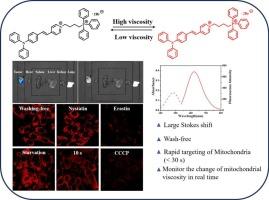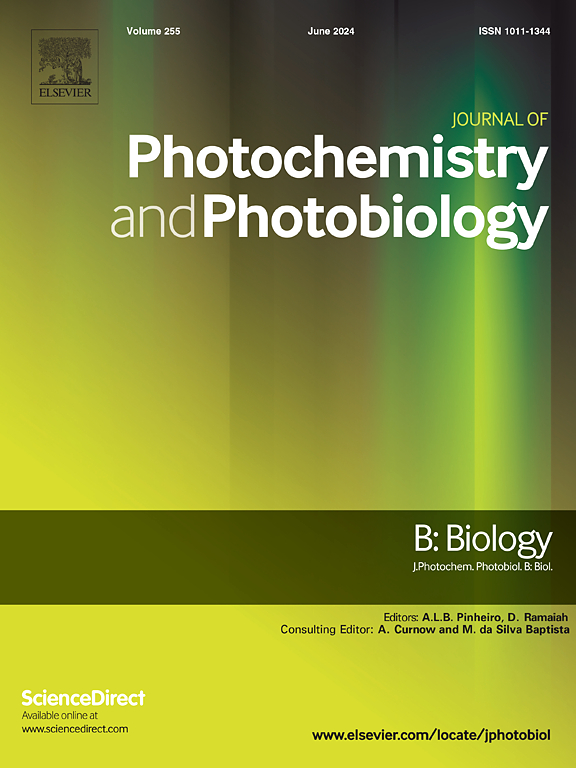一种免洗红色荧光探针,用于实时监测线粒体粘度变化和肿瘤成像
IF 3.7
2区 生物学
Q2 BIOCHEMISTRY & MOLECULAR BIOLOGY
Journal of photochemistry and photobiology. B, Biology
Pub Date : 2025-05-09
DOI:10.1016/j.jphotobiol.2025.113182
引用次数: 0
摘要
线粒体是细胞内重要的产能细胞器,其微环境黏度异常与癌症等疾病密切相关。目前检测粘度的方法仍然存在许多局限性,而荧光成像技术可以解决这些缺点。因此,迫切需要开发能够检测线粒体粘度变化的荧光探针。本研究以三苯胺衍生物为核心结构,通过缩合反应引入不同的三苯基膦衍生物,合成了三种具有D-π-A结构的红色荧光探针。系统地研究了它们的光物理性质,发现它们不仅对粘度敏感,而且具有很强的抗干扰能力。其中,探针TPAP2具有优异的光学性能,包括大的斯托克斯位移和对粘度的高灵敏度。发现TPAP2是线粒体靶向的,无需洗涤,快速(10秒),靶向过程取决于线粒体膜电位。该探针已成功应用于小鼠皮下肿瘤的成像。本文章由计算机程序翻译,如有差异,请以英文原文为准。

A wash-free red fluorescent probe for real-time monitoring of mitochondrial viscosity changes and tumor imaging
Mitochondria are important energy-producing organelles within cells, and abnormalities in the viscosity of their microenvironment are closely related to diseases such as cancer. Current methods for detecting viscosity still suffer from many limitations, whereas fluorescence imaging techniques can address these shortcomings. Therefore, there is an urgent need to develop fluorescence probes capable of detecting changes in mitochondrial viscosity. In this study, derivatives of triphenylamine were used as the core structure, and different triphenylphosphine derivatives were introduced through a condensation reaction to synthesize three red fluorescence probes with a D-π-A structure. Their photophysical properties have been systematically studied and it has been found that they are not only sensitive to viscosity but also exhibit strong anti-jamming capabilities. Among them, probe TPAP2 exhibits excellent optical properties, including large Stokes shifts and high sensitivity to viscosity. It was found that TPAP2 is mitochondria-targeted, washing-free, and fast (<10s), with the targeting process depending on the mitochondrial membrane potential. The probe has been successfully applied to tumor imaging in mice with subcutaneous tumors.
求助全文
通过发布文献求助,成功后即可免费获取论文全文。
去求助
来源期刊
CiteScore
12.10
自引率
1.90%
发文量
161
审稿时长
37 days
期刊介绍:
The Journal of Photochemistry and Photobiology B: Biology provides a forum for the publication of papers relating to the various aspects of photobiology, as well as a means for communication in this multidisciplinary field.
The scope includes:
- Bioluminescence
- Chronobiology
- DNA repair
- Environmental photobiology
- Nanotechnology in photobiology
- Photocarcinogenesis
- Photochemistry of biomolecules
- Photodynamic therapy
- Photomedicine
- Photomorphogenesis
- Photomovement
- Photoreception
- Photosensitization
- Photosynthesis
- Phototechnology
- Spectroscopy of biological systems
- UV and visible radiation effects and vision.

 求助内容:
求助内容: 应助结果提醒方式:
应助结果提醒方式:


